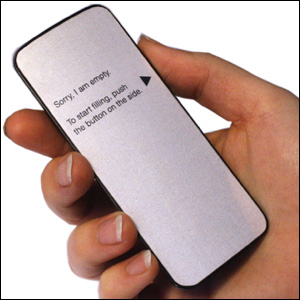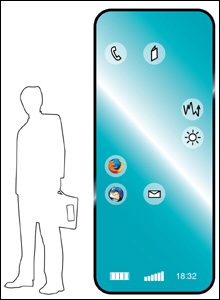
If
the Apple iPhone ushered in anything, it was the era of the user interface
- at least in the mobile world. Not that traditional S60 or UIQ or
Windows Mobile phones were THAT hard to use - but Apple's
built-from-the-ground-up interface was so jaw droppingly simple and
obvious. Now, arguably, part of the simplicity was also down to the
fact that the iPhone also couldn't do that much - but I contend that
the modern smartphone has to be able to fulfill a lot of separate
functions and, where you have functions, you'll need icons. The more a
smartphone does, the more icons and options you'll need, and so on.
As Apple are about to find out in the next year, I suspect - just look at the iPhone fans filling up homescreen after homescreen with shortcuts and web clips with the latest firmware...
All of which piqued my interest in a concept device called the Vase, designed by students at the Royal College of Art for a 3-sponsored project. Rather than start off with all its applications in your face from the start, it presents its interface as an empty vessel (hence the name), into which you start pouring the apps you want.
The first thing I do with any S60 smartphone, for example, is to hide away the applications that Nokia quite likes but which I never need. The Vase presents the opposite way of working.
For example, you'd turn it on and a welcome message would pop up, "Sorry, I am empty", plus "To start filling, push the button on the side", as shown above. Then, presumably, half a dozen 'Would you like to' questions, e.g. 'Would you like to add email now?' or 'Would you like to add a Calendar now?'. The novice user would soon have a handful of basic apps shown and working and at any point could tap on something like 'Add another function', choosing from a list of possibles. At no point would they get overwhelmed by stuff they didn't need yet.
This behaviour is kind of mirrored in games consoles like the Nintendo Wii, which start you with very little on its opening menu and then you gradually add channels at your own pace and in your own time.
 Of course, the Vase concept will annoy power users intensely, so
maybe there should be a single question right at the start of the
welcome wizard: (as Ewan puts it) "Are you Steve Litchfield?",
in which case all the apps and settings would appear without further
ado...
Of course, the Vase concept will annoy power users intensely, so
maybe there should be a single question right at the start of the
welcome wizard: (as Ewan puts it) "Are you Steve Litchfield?",
in which case all the apps and settings would appear without further
ado...
The Vase's (concept) creators also say, intriguingly, that the device shouldn't need a manual, as users would learn how the interface and apps worked as they went along, adding functionality when the felt ready. I think this is a given, actually, for any modern or next-gen phone. Who reads manuals? I know I haven't for any device for years...
But an interface whose apparent complexity grows as you use it is a great idea. Microsoft Office on the desktop had the idea years ago of hiding rarely used menu functions from users - this was much maligned but I rather liked the concept. With a little tweaking, the idea would work well in mobile, with menu functions staying visible once you'd used them, of course.
Comments welcome if you've got an opinion on the best way to handle application overload....
Steve Litchfield, AllAboutSymbian, 19 Feb 2008
